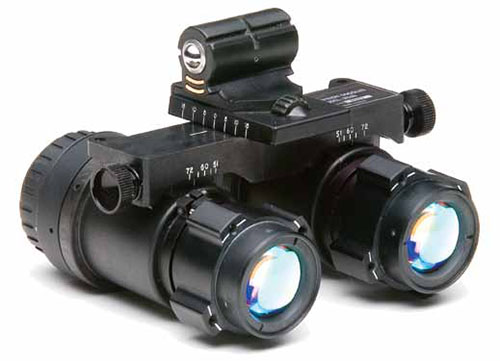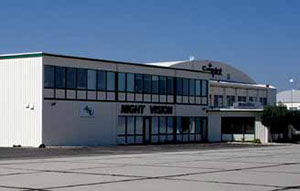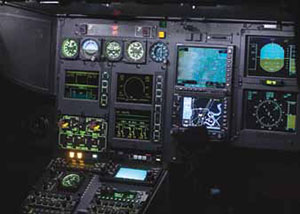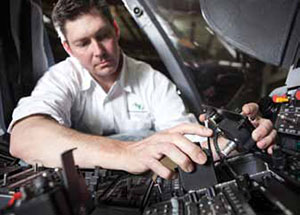
NVIS – I Can See Clearly Now


Let’s face it — we are a species of the light. Once it gets dark, we no longer have the ability to see as we could in daylight. This decline in visual acuity has been with us as long as we have walked the earth. The inability to see well in the dark has also restricted us in our ability to fly helicopters at night safely … until recently. In January 1999, a night-vision imaging system (NVIS) entered the world of commercial aviation for the first time. The FAA issued an STC that allowed the use of night-vision goggles (NVG) by a civilian helicopter operator who was providing EMS. And so it began; the night was no longer a restriction to flying safely in the dark.
The advantages that NVIS technology brings to helicopter operations are numerous. It improves flight crew situational awareness and dramatically reduces the possibility of a collision with terrain or man-made obstructions. It increases safety significantly when flying in the dark, and safety is what it is all about.
A Little History
The first thing you probably think of when you see the words “night vision”is a spy or action movie you’ve seen, in which someone straps on a pair of NVG to find someone else in a dark building on a moonless night. You might have wondered, “Do those things really work? Can you actually see in the dark?” The answer is most definitely yes.
Image-enhancement technology is what most people think of when you talk about night vision. In fact, image-enhancement systems are normally called night-vision devices (NVDs). An NVD is an optical instrument that uses an image intensifier unit to enhance light on low-light situations. Night-vision systems were originally developed and used by law enforcement personnel or military. NVG typically consist of an image intensifier tube, a protective (and in most cases water-resistant) housing, and some type of mounting system. Many of these devices also include interchangeable objectives, diode or laser-infrared illuminators, and additional telescopic lenses.
Night-vision devices found their first real-life use at the end of World War II, and came into general service for military operations during the Vietnam war. The technology has enhanced greatly since the first devices became available, leading to several image intensifier “generations” for night-vision equipment. Each time a new generation image intensifier is available to end users, its technical performance has increased and its price decreased. Today, we are up to “Generation 3-plus” equipment.
 Headquartered in Boise, ID, Aviation Specialties Unlimited (ASU) provides night-vision technology for aircraft, as well as several services designed to keep the NVIS operation in the highest working order. ASU helps pilots understand how to operate the equipment, performs NVIS modifications to aircraft, inspects and repairs goggles, and provides customized training for pilots and crew members. Training services available through ASU include initial night-vision flight training, night-vision instructor pilot training, recurrent night-vision training courses, and Part 141 flight school – rotorcraft helicopter. ASU also offers charter and contract services.
Headquartered in Boise, ID, Aviation Specialties Unlimited (ASU) provides night-vision technology for aircraft, as well as several services designed to keep the NVIS operation in the highest working order. ASU helps pilots understand how to operate the equipment, performs NVIS modifications to aircraft, inspects and repairs goggles, and provides customized training for pilots and crew members. Training services available through ASU include initial night-vision flight training, night-vision instructor pilot training, recurrent night-vision training courses, and Part 141 flight school – rotorcraft helicopter. ASU also offers charter and contract services.
ASU has more than 700 operational commercial installations, and has a large portfolio of STCs for NVIS lighting modifications. Standard NVG cockpit modifications include a combination of Aviator’s night-vision imaging system (ANVIS) compatible filters, bezels, internal modifications and lighting components to modify all instrumentation in both the cockpit and cabin. With these qualifications, I have asked them to shed some light on NVIS.


HeliMx– From an aviation perspective, what is the purpose of an NVIS?
ASU– A night-vision goggle (NVG) is an optical instrument that allows images to be produced in levels of light approaching total darkness. The major benefit of the NVG system, when properly performed with both current technology NVGs and a properly modified aircraft, is to improve the visual acuity of the pilot from 20/200 (legally blind – and what the unaided human eye can see at night) to up to 20/20 visual acuity. They are most often used by military and law enforcement agencies, but are available to civilian users most typically associated with helicopter EMS organizations. The aircraft must be modified to not interfere with the night-vision goggles and allow it to be fully utilized so that it is not hindered by non-compatible lighting within the cockpit. This is accomplished by modifications utilizing lighting and filtration that is unobtrusive to the night-vision goggles and does not produce glare and reflections in the interior windscreens affecting outside visual acuity.
HeliMx– In what way, if any, has the system been optimized for use in helicopters?
ASU– The modification is not different between fixed- and rotor-wing applications as its overall goal is the same between the two types of airframes. ASU has STCs for both fixed- and rotor-wing aircraft.
HeliMx– Is the system designed to be single or dual?
ASU– The system, as designed and worn by the pilot and co-pilot, is dependent on the aircraft requirements (i.e., if the aircraft is single pilot, then the system is compatible with that aircraft type design). NVG aircraft are modified and are designed for night VFR operations as the NVG is a visual device and is not designed to see “through” clouds and or visual impairments like fog and/or smoke.
HeliMx– Is there a sensor package required for the system?
ASU– There are no sensor packages required for the system. However, the aircraft must be modified and/or purposely built for compatibility with the NVGs. The NVG is a portable, self-contained pilot system and is not directly attached to and/or powered by the aircraft.

HeliMx– Is there a requirement on the type of panel lighting required?
ASU– Aircraft lighting must be modified and/or purposely built for NVG usage. The pilot views the instrumentation and avionics by looking underneath the NVG to view the instrumentation. The pilot only uses the NVG to look outside the aircraft and views all interior items unaided. The aircraft modification is only to reduce and/or eliminate the glare and reflections on the windscreen that are created by incompatible light sources within the aircraft.
HeliMx– Is the system customizable by the operator?
ASU– ASU STCs are designed with consideration to the OEM design and customized to support the unique configurations of each aircraft model. However, the FAA has mandated that a high level of configuration and conformity control must be maintained on NVIS-modified equipment. This also applies to any modifications made to the aircraft in the installation of new equipment and or different configurations. If that is the case, then the STC must be amended to reflect these changes and must be concurrently FAA approved in the new configuration.
HeliMx– Does it matter if the aircraft is flying IFR or VFR?
ASU– NVG flight is strictly for VFR use only. Some misunderstandings exist pertaining to the ability of NVGs to look through fog, clouds, etc. Understanding the NVIS functional characteristics as well as education on the equipment and experience in flight quickly dispels this myth. The use of NVGs does not preclude the aviator from entering IFR conditions. However, with proper ground and flight training, they significantly reduce the chance of the occurrence. NVGs are mounted on the helmet and if properly adjusted, will be approximately one to two inches in front of the pilot’s eyes. If the pilot does not pay proper attention to the visual cues and find they have encountered IFR conditions, they can quickly transition to the instruments underneath their goggles, and with their unaided eye fly IFR as needed to recover the aircraft to VFR.
HeliMx– Who typically does an installation and how long does the installation take?
ASU– We will conduct the installation on site at the customer’s facility, or it can be accomplished in Boise, ID, at ASU’s hangar. Ninety-nine perent of ASU’s installations are completed at the customer’s facility. A typical installation requires less than one week for the physical modification, with return to service conducted by ASU within 10 days post installation (typically within five days), under ASU’s FAA Part 145 repair station certificate.
HeliMx– Are there any special mechanical or electrical considerations to be considered for an installation?
ASU– ASU conducts an electrical load analysis review with the customer prior to the modification. Most NVIS systems actually reduce the electrical load on the aircraft with the use of modern LEDs and other power-reducing technologies.
HeliMx– How is the system tested?
ASU– During the initial STC verification process, a rigorous ground and flight-testing phase is conducted in cooperation with the FAA’s Seattle Aircraft Certification Office (SACO). Subsequent aircraft may require ground and/or flight testing by appropriately-rated designated engineering representatives (DERs) or FAA flight analysts. Each aircraft is tested post installation for both Class A and B NVG applicability and compatibility. The test utilizes the appropriate NVGs and an FAA-approved/accepted test plan document which is kept as part of the record for that modification and is submitted post-installation to the FAA (SACO).
HeliMx– What is the test looking for?
ASU– The test is looking for any glare and reflection in the interior windscreens and/or transparencies or distracting glare and/or blooming from lighted equipment.
HeliMx– Is any field calibration required on any type of schedule?
ASU– There are 100-hour and annual inspection requirements within the ICAs for the aircraft modification. The NVGs have 180-day requirements for inspection and calibration.
HeliMx– From a maintenance perspective, how should the NVG goggles be handled?
ASU– NVGs are an electro-optical device and therefore, due to the overall cost of the unit combined with its design, should be handled in a similar manor as any expensive camera or electronic equipment.
HeliMx– How should NVIS be cleaned?
ASU– The owner/operator manual has a detailed instruction section on cleaning and care of the NVGs. The ICA contained within the data for the STC also details the cleaning and inspection criteria for the aircraft modification.
HeliMx– What are some of the most common problems you see with the system and how can the operator minimize or eliminate them?
ASU–The most common problem seen with an NVIS modification and the use of NVGs is that the operators do not keep the aircraft maintained in accordance with the STC limitations. Additionally, they let the NVG’s 180-day inspection/calibration requirement lapse due to a lack of tracking of the NVG’s last inspection. When an NVIS-modified unit is replaced due to a maintenance need (whether due to a failure of the unit or damage to a filter or light assembly), a replacement is installed quite often without the NVIS modification correctly applied. This results in an unmodified unit being installed that may impact visual acuity with incompatible light.
A newer development that has been seen in the field is when an operator has two aircraft modified by different NVIS modifiers and equipment is being swapped back and forth between the aircraft. This creates a serviceability issue as well as a conformity problem, in that there are two STCs for the NVIS modifications and the FAA does not allow “mixing” of the two modification processes. For example, ASU STCs are produced to allow for both Class A and B NVGs, wherein other modifiers have chosen to only modify the aircraft for the lesser-performance Class B NVGs (approximately five- to ten-percent resolution reduction). When these units are mistakenly installed in a Class A cockpit, the outside visual acuity may be reduced due to the lesser-performing Class B NVIS modification. Also, the continued airworthiness will not support the other modifiers “type design” modification and vice versa.
HeliMx– What preventative maintenance tips can you recommend?
ASU– Closely follow both the NVG manufacturer’s and STC vendor’s limitations, inspection requirements and continued airworthiness requirements.
HeliMx– Any lessons learnedyou can share?
ASU– Conformity and configuration control of your NVIS-modified aircraft should be one of the items at the forefront of your maintenance concerns. Regular and in-depth reviews of the STC data and limitations should be performed to ensure the aircraft is maintained properly. Are all of the items installed in accordance with the STC data? Is the aircraft equipment in accordance with configuration control of the STC data?
Can you see me now? With NVIS, the answer is a resounding yes! With NVIS becoming a more popular tool to enhance flight safety, I am sure that if your flight department will use it soon if you’re not already. Thanks to the folks at ASU for sharing their expertise and insight.
